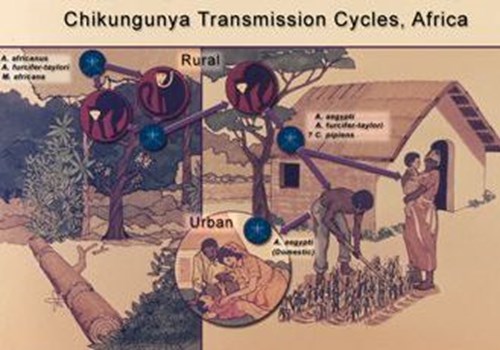Chikungunya virus

Chikungunya virus causes a painful, crippling disease, and is transmitted by infected mosquitoes. The name is derived from a native language of Tanzania, and refers to the stooped, contorted appearance of sufferers with severe joint pain. Other symptoms are similar to those caused by dengue and zika disease, and misdiagnosis is common in areas where all these viruses circulate.
The severity of joint pain can range from very mild to severe, and last for a few days or weeks. In some cases, arthritis may persist for months or years, and other organ complications can also occur. In older people the disease can contribute to the cause of death.
The virus is transmitted by infected mosquitoes, most commonly Aedes aegypti in tropical or subtropical regions, or A. albopictus in more temperate regions such as southern Europe. The virus cannot be spread directly from person to person. Aedes mosquitoes are not currently established in the UK, as the temperature is not consistently high enough for them to breed. Ongoing surveillance has detected occasional incursions of these mosquitos from the continent since 2016, and it is likely that the vector will continue to be introduced over the next decade. Computer simulations suggest that with climate change, temperatures will be sufficient in London for at least one month of virus transmission by 2041-2070, and across most of south-east England for 1-3 months by the end of the century.
Laboratory diagnosis is by serological tests to detect antibodies to the virus, or by various RT-PCR methods, to detect viral RNA. During the first few days of infection, the virus itself may be isolated from blood. There are three distinct genotypes, West African, East/Central/South African (ECSA), and Asian. Some ECSA strains share a genetic mutation that facilitates replication in A. albopictus mosquitoes.
No vaccines or specific antiviral treatments are available. Treatment is based on supportive nursing and treatment of symptoms only. Prevention of infection relies on avoiding mosquito bites. The virus was first isolated from patients during an outbreak in southern Tanzania in 1952. It has since been identified in over 60 countries in Asia, Africa, Europe and the Americas.
Significant outbreaks occurred in islands of the Indian Ocean in 2005, in India in 2006, and in the Pacific islands since 2014. The first transmission in Europe was reported in Italy in 2007. In 2013 the virus spread to another continent, with a large outbreak in Central and South America.
In the autumn of 2017, outbreaks occurred in both France and Italy. Sequence analysis of virus isolated in France indicated that it belongs to the ECSA lineage. The virus carried a mutation that has been associated with transmission by A. albopictus as well as A. aegypti. The chikungunya outbreak in France appears to have ended in October 2017.
Sequence analysis of virus isolated from the outbreak in Italy indicated that the virus is also ECSA lineage but a current Pakistan strain and without the mutation noted in the French cases. As of 10th November 2017, this outbreak is ongoing, with 428 cases reported.
Related Links
Chikungunya strans available from NCPV
References
GOV.UK (25 April 2014). Guidance: Chikungunya. Retrieved from https://www.gov.uk/guidance/chikungunya
WHO (updated April 2017). Fact Sheet: Chikungunya. Retrieved from http://www.who.int/mediacentre/factsheets/fs327/en/
WHO (15 September 2017). Disease Outbreak News: Chikungunya - Italy. Retrieved from http://www.who.int/csr/don/15-september-2017-chikungunya-italy/en/
Travel Health Pro (22 September 2017). Chikungunya Outbreak in Italy – Summer 2017 Retrieved from https://travelhealthpro.org.uk/news/250/chikungunya-outbreak-in-italy--summer-2017
CDC (updated 12 May 2016). Chikungunya Virus. Retrieved from https://www.cdc.gov/chikungunya/geo/index.html
ProMED mail (06 January 2018). Chikungunya (01): Americas, Europe, Asia, research (Archive Number: 20180106.5541396). Retrieved from https://www.promedmail.org/
ProMED mail (10 November 2017). Chikungunya (45): Italy, France (Archive Number: 20171110.5435925). Retrieved from https://www.promedmail.org/
